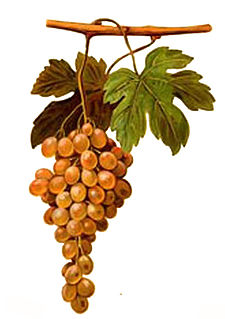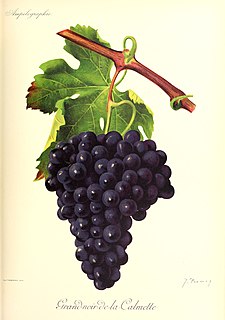Related Research Articles

Alicante Bouschet or Alicante Henri Bouschet is a wine grape variety that has been widely cultivated since 1866. It is a cross of Petit Bouschet and Grenache. Alicante is a teinturier, a grape with red flesh. It is one of the few teinturier grapes that belong to the Vitis vinifera species. Its deep colour makes it useful for blending with light red wine. It was planted heavily during Prohibition in California for export to the East Coast. Its thick skin made it resistant to rot during the transportation process. The intense red color was also helpful for stretching the wine during prohibition, as it could be diluted without detracting from the appearance. At the turn of the 21st century, Alicante Bouschet was the 12th most planted red wine grape in France with sizable plantings in the Languedoc, Provence and Cognac regions. In 1958, Alicante Bouschet covered 24,168 hectares ; by 2011, plantings represented less than 4,000 hectares. This scenario is largely reversed in other regions of Europe, and in southern Portugal, where its wines are highly prized and frequently outscore traditional autochthonous varieties.

Tempranillo is a black grape variety widely grown to make full-bodied red wines in its native Spain. Its name is the diminutive of the Spanish temprano ("early"), a reference to the fact that it ripens several weeks earlier than most Spanish red grapes. Tempranillo has been grown on the Iberian Peninsula since the time of Phoenician settlements. It is the main grape used in Rioja, and is often referred to as Spain's noble grape. The grape has been planted throughout the globe's wine regions.

Pedro Ximénez is the name of a white Spanish wine grape variety grown in several Spanish wine regions but most notably in the denominación de origen (DO) of Montilla-Moriles. Here it is used to produce a varietal wine, an intensely sweet, dark, dessert sherry. It is made by drying the grapes under the hot sun, concentrating the sweetness, which are then used to create a thick, black liquid with a strong taste of raisins and molasses that is fortified and aged in solera.

Portuguese wine is the result of traditions introduced to the region by ancient civilizations, such as the Phoenicians, Carthaginians, Greeks, and mostly the Romans. Portugal started to export its wines to Rome during the Roman Empire. Modern exports developed with trade to England after the Methuen Treaty in 1703. From this commerce a wide variety of wines started to be grown in Portugal. And, in 1758, one of the first wine-producing regions of the world, the Região Demarcada do Douro was created under the orientation of Marquis of Pombal, in the Douro Valley. Portugal has two wine-producing regions protected by UNESCO as World Heritage: the Douro Valley Wine Region and Pico Island Wine Region. Portugal has a big variety of local kinds, producing a very wide variety of different wines with distinctive personality.

Alentejo is a Portuguese wine region in the Alentejo region. The entire region is entitled to use the Vinho Regional designation Alentejano VR, while some areas are also classified at the higher Denominação de Origem Controlada (DOC) level under the designation Alentejo DOC. VR is similar to the French vin de pays and DOC to the French AOC. In the southern half of Portugal, the Alentejo region covers about a third of the country and is sparsely populated. In 2005, South Oregon University scientist Gregory V. Jones identified Alentejo as the world's most challenged wine region from a climate change perspective. The region is noted for it vast cork production but has in recent years garnered attention for its table wine production. Some producers of this region still do wine in great potteries as in Roman times.

Grand Noir de la Calmette is a red teinturier grape variety that is a crossing of Petit Bouschet and Aramon noir created in 1855 by French grape breeder Henri Bouschet at his vineyard in Mauguio in the Hérault department. The grape was named after the breeding station Domaine de la Calmette. As a teinturier, Grand noir is often used to add color to wines that it is blended into but is paler than other choices such as Alicante Bouschet. The vine tends to bud late and has a high productivity but with some susceptibility to the viticultural hazard of powdery mildew.
Granja-Amareleja is a Portuguese wine region centered on the town of Mourão in the Alentejo region. The region was initially a separate Indicação de Proveniencia Regulamentada (IPR) region, but in 2003, it became one of eight subregions of the Alentejo DOC, which has the higher Denominação de Origem Controlada (DOC) status. Its name may still be indicated together with that of Alentejo, as Alentejo-Granja-Amareleja.
Moura is a Portuguese wine region centered on the town of Moura in the Alentejo wine region. The region was initially a separate Indicação de Proveniencia Regulamentada (IPR) region, but in 2003, it became one of eight subregions of the Alentejo DOC, which has the higher Denominação de Origem Controlada (DOC) status. Its name may still be indicated together with that of Alentejo, as Alentejo-Moura.
Redondo is a Portuguese wine region centered on the Redondo municipality in the Alentejo region. The region was initially an Indicação de Proveniencia Regulamentada (IPR) region, then elevated to Denominação de Origem Controlada (DOC) status. In 2003, it became one of eight subregions of the Alentejo DOC. Its name may still be indicated together with that of Alentejo, as Alentejo-Redondo.
Reguengos is a Portuguese wine region centered on the Reguengos de Monsaraz municipality in the Alentejo region. The region was initially an Indicação de Proveniencia Regulamentada (IPR) region, then elevated to Denominação de Origem Controlada (DOC) status. In 2003, it became one of eight subregions of the Alentejo DOC. Its name may still be indicated together with that of Alentejo, as Alentejo-Reguengos.
Vidigueira is a Portuguese wine region centered on the Vidigueira municipality in the Alentejo region. The region was initially an Indicação de Proveniencia Regulamentada (IPR) region, then elevated to Denominação de Origem Controlada (DOC) status. In 2003, it became one of eight subregions of the Alentejo DOC. Its name may still be indicated together with that of Alentejo, as Alentejo-Vidigueira.
Roupeiro is a white Portuguese wine grape planted primarily in the Alentejo and Douro regions. In Alentejo, the grape is known as Alva. In the Douro, it is known as Codega.
Arinto or Arinto de Bucelas is a white Portuguese wine grape planted primarily in the Bucelas, Tejo and Vinho Verde regions. It can produce high acid wines with lemon notes.
Azal branco is a white Portuguese wine grape planted primarily in the Minho region but with greater expansion to Amarante, Basto, Baião and Vale do Sousa sub-regions. It noted for the high acidity of its wines, and is used for white Vinho Verde. Varietal Azal Branco wines can be somewhat reminiscent of Riesling.

Cayetana blanca, also known as Cayetana or Jaén, is a white Spanish wine grape. It is grown mainly in the south of Spain, especially in Extremadura and in the Jerez region where it is distilled for use in brandy production.

Baga is a red Portuguese wine grape variety planted primarily in the Bairrada DOC. As a varietal, Baga produces tannic wines with high acidity.

Espadeiro is a red Portuguese wine grape planted primarily in the Minho region for making Vinho Verde. It is also grown across the border, in Galicia (Spain) where it is used to make light bodied wines.
Parraleta is a red Spanish wine grape variety which might also be known under various other names, such as Tinta Caiada in several Mediterranean countries. Parraleta is chosen as a prime name as it was used in Somontano, region located in the north-east Spain, which is its likely place of origin. DNA profiles of Tinta Caiada, and Carenisca, and Salceño Negro with that of Parraleta suggests that they are one and the same variety.
Mureto is a red Portuguese wine grape variety.
References
- 1 2 "Moreto". Vitis International Variety Catalogue . Archived from the original on 2010-01-24. Retrieved 2010-01-30.
- ↑ J. Robinson Jancis Robinson's Wine Course Third Edition pg 144 Abbeville Press 2003 ISBN 0-7892-0883-0